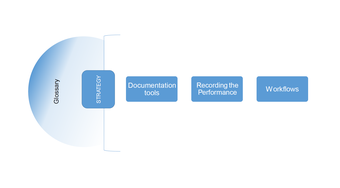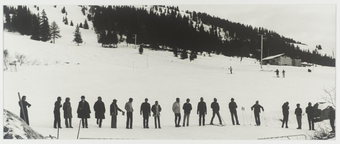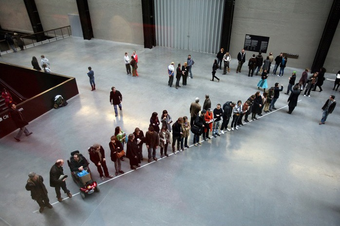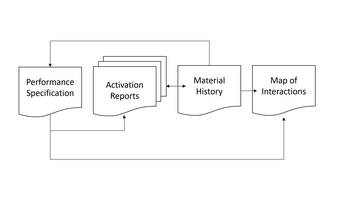Introduction
Performance has been collected at Tate since 2005, with Good Feelings, Good Times 2003 by Roman Ondak being the first performance work to be acquired. These artworks fall within the remit of the time-based media conservation team, who have worked to document and conserve them. The approach to the conservation of performance was developed in the years following this first acquisition by applying existing conservation practice, working to understand each artwork and considering the short- to long-term needs of each work. At this early stage, existing documentation strategies and templates used for time-based media artworks were adapted.
The approach to the documentation and conservation of performance works in the collection was revisited in early 2016, prompted by an increase in the number of performances works being collected and their increasing complexity. It was also prompted by the display of five performance works across the opening weekend of the Blavatnik Building, Tate Modern in June 2016: Amalia Pica’s Strangers 2008, David Lamelas’s Time 1970, Roman Ondak’s Good Feelings in Good Times 2003, Tania Bruguera’s Tatlin’s Whisper #5 2008 and Tino Sehgal’s This is Propaganda 2002. These five works were performed across a three-week programme called BMW Tate Live. At this moment in time, Tate had ten performance works in the collection, so the presentation of half the collection provided a unique moment to reflect on practice. Work to develop approaches to the documentation and conservation of performance has continued through the delivery of cross-disciplinary workshops, a formalised performance team in conservation, and practical application and reflection.
The aim of the strategy is to retain the ‘liveness’ of a performance – the ability to activate it – and so it focuses on collecting information around the constant elements of what that performance is, or perhaps needs to be, in order to exist. Moving away from the idea of capturing the ‘original’ or first performance, the strategy aims to continuously capture the concept of the artwork; doing so permits the work to breathe and develop with each activation.
The strategy has developed three core strands: documentation tools, capture of performance and workflows. It also includes the formulation of a glossary of terms, which was designed to represent its overarching conceptual framework.

Fig.1
Diagram illustrating the three key areas of the Strategy for the Documentation and Conservation of Performance
The documentation process is not simply about recording the artwork, the ‘live moment’ of the performance or the actions undertaken by the performers at a given moment. It is about the full range of the activities undertaken within the scope of time-based media conservation to allow the work to be activated repeatedly; it focuses on the process of documenting the work, rather than the creation of a fixed, singular document. The current documentation templates and workflows have been developed to answer current needs in conserving performance artworks; its basic framework is flexible and alterations can be made to adapt to works with, for example, a stronger sculptural element.
As reflections arise during the use of the strategy, it can adapt and shift to suit new needs. Documentation tools and strategies for recording performance are at the core of the overall strategy and can be revised, adapted and applied to a wide range of institutional and non-institutional contexts. Workflows developed in the context of our practice are related to Tate and might not be so easily translated to other contexts where performance art lives in a different way. This is the reason why the theoretical framework, documentation tools and recording strategies will be the focus of the sections that follow.
Development of the Strategy: Some Notes on a Process
This text highlights the main conclusions on the development of a strategy for the documentation and conservation of performance. It aims to communicate a practice-led research process while also exploring practical tools and theoretical frameworks that can be used by conservators, archivists, artists and any other professionals working towards the ongoing care of performance-based artworks.
The development of the strategy for the Documentation and Conservation of Performance was a gradual process, which built on varying stages of discussion, research, implementation and reflection. The process can be described as practice-led, in line with current research undertaken within the time-based media conservation team at Tate. Influenced by the research network Collecting the Performative (2012–14), the research project Performance at Tate: Collecting, Archiving and Sharing Performance and the Performative (2014–16) and the BMW Tate Live programme, the latter of which enabled practice to be directly linked to research, the strategy engages with the notion of knowledge sharing through practice in two core ways:
- By engaging directly with inter-departmental practices of documentation to collate diverse perspectives from a range of stakeholders, including, for example, curatorial, learning and conservation, to create a centralised set of streamlined documents as part of the strategy.
- By acknowledging that this set of documents will not only circulate within Tate, but also between other arts institutions when performance works are loaned. Therefore the information contained and captured needs to be complete and clear enough to be useful to those activating the works beyond Tate.
The first stage of developing the strategy was to discuss the work with the conservation and curatorial departments most closely associated with the collection, activation and continuity of performance artworks. These discussions happened within the two departments, as well directly between Louise Lawson (Conservation Manager, Time-based Media), Acatia Finbow (Collaborative Doctoral Researcher) and Isabella Maidment (Assistant Curator of Performance) to establish what was needed and expected from a documentation process.
Having established the institutional needs for the strategy, the practical generation and implementation led to the development of the first tool, called Performance Specification. This was feasible thanks, in part, to a Collaborative Doctoral Award (CDA) attached to the AHRC Performance at Tate research project which was in process in 2016. The CDA resulted in Acatia Finbow’s thesis, The Value of Performance Documentation in the Contemporary Art Museum: A Case Study of Tate, which traced the history of performance documentation processes and products at Tate.1 Working alongside time-based media conservation, existing documentation practices were analysed and reflected upon, along with speculation on future processes, which all fed into the shaping of the current Performance Specification.
The time-based media conservation team has used documentation practices to capture the intricacies of not only the work, but the activities of production and activation of the work within the institution. For each performance artwork in Tate’s collection, the time-based media conservation team has created an artwork record, which formed a body of information from the point of acquisition, including correspondence with the artist, through to all the performance histories since the work entered the collection. This type of record has not been overwritten by the process of reassessing documentation practices around performance artworks; rather it has been incorporated into it to ensure that, at the heart of the process, there is the joint consideration of what the artwork is and what it can become.
What is Conserved?
One of the issues that became apparent through the development of the Glossary of Terms was the importance of framing our conservation practice in our understanding of what it means to conserve performance art at Tate.
The conservation of performance art, along with the interrelated genre of Live Art and the broader medium of performance itself,2 is quite a recent ambition within conservation, with few dedicated studies being developed around the theme in either academic or institutional contexts. The majority of efforts in this direction are either geared towards individual projects or stem from the experience of institutions collecting performance artworks.3 Collecting the Performative and the aforementioned project Performance at Tate were important turning points for the development of the strategy and of the team’s understanding of what, in performance art, can and should be conserved.
A performance cannot be exactly repeated; it will be different each time it is activated and therefore one can expect additions or omissions with each performance. This may involve a conversation with the artist to consider the evolution of the performance over time. With each performance it is critical to understand the elements that are constant and what is in flux.

Fig.2
Photograph of the first performance of Time 1970 by David Lamelas, in the French Alps in 1970. Lamelas took a photograph each moment the performers told the time to each other; it is not clear which moment is portrayed in this document.
Photo © David Lamelas

Fig.3
Time 1970 by David Lamelas, performed 26–27 January 2008, as part of the curatorial programme UBS Openings: Live – The Living Currency at Tate Modern
Photo © Tate
The aim of the strategy is to gather sufficient information to activate works, balanced against the need to retain the liveness and consequent inherent changeability of the work. Failure to strike this balance could result in an overly rigid approach to future activations, risking lessening the impact of the work. It is an interesting juxtaposition to capture suitable levels of information while not documenting the work so rigidly that it removes the ‘soul’ of the artwork. Take as an example of this changeability David Lamelas’s Time. Figs.2 and 3 show two activations, one from the earliest documented activation in 1970 and one from 2016.
This strategy implies a process in perpetual construction and revision, with multiple moments of feedback generated by the artwork’s activation. In this sense, a work of performance art is documented through consideration of what it needs to be activated at this point in time and in the future.
Glossary of Terms
The glossary of terms was developed through targeted workshops across late 2018 and early 2019 within the Documentation and Conservation of Performance project team at Tate, and it was an important step in refining the subsequent tools. The choice of language and terminology shapes the dialogue around performance-based artworks and, as such, is grounded in change and variety. The glossary relates to terminology used in the context of existing practice within the time-based media conservation team, but it is also expanded upon using language from across the wider performance and conservation fields.
Performance
‘Performance’ is used to describe an artwork which has a specificity of performance or performative elements. Tate’s Art Terms entry on ‘Performance Art’ defines it as ‘artworks that are created through actions performed by the artist or other participants, which may be live or recorded, spontaneous or scripted’. In the context of this strategy, it is considered that performance has a dormant, active and installed presence – existing in all three modes at varying points during its life within the institution.
Performance-based
‘Performance-based’ is used to describe works where performance is the central medium of the work but is not necessarily the only aspect of the expanded artwork. The artwork might have more perennial materialisations (such as a sculpture or an installation) but has elements that can be (or have been) activated as performance.
Activation
‘Activation’ is used to describe the process of preparing the performance for display and presenting it in an active and live manner. Activation is selected over any word using ‘re:’ as this prefix promotes the concept of originality; ‘activation’ instead adheres to an idea of continuity in the artwork.4
When the work is in its ‘active state’ it is in the process of being performed.
Installed State
‘Installed state’ is used to describe the performance once it is installed – even if this is for the briefest of moments – but not yet activated by its performers; it can therefore be seen by visitors to the museum, but it is not yet in an active state.
Dormant State
In the ‘dormant state’, the performance-based artwork will have no physical presence in the institution and will not be publicly viewable or accessible. While there may be components of the artwork preserved and stored by the institution, the performance element is not manifest physically in any way while in this state. It is important to note that this does not constitute a ‘disappearance’ of the work, but rather a change in visibility and accessibility.
Constant
‘Constant’ is used to describe the elements within a performance, as described by the artist, which must be present for the performance to exist.
Flux
‘Flux’ is used as the opposite to ‘constant’, to describe all of the elements that, as part of the performance, can change, do change and will change.
Interaction
In the context of the present strategy, ‘interaction’ might be considered as either an action between two entities that results in changes in either of those entities or in their surrounding context, or as the interactions that need to exist or take place for the artwork to be performed.5
The documentation lifecycle: a brief look into our tools
The current strategy for the conservation of performance artworks at Tate tries to encompass the different moments of the life of artworks in this institution. Conserving these works in Tate’s structural system requires that they be traceable, trackable and accessible so that they can be activated now and in the future. Besides our Glossary, we have created four documentation tools (Performance Specification, Activation Reports, Material History, Map of Interactions), three workflows (acquisition, exhibition and displays, loans) and a review of the status of the documents gathered in the process.
The documentation tools have their own lifecycle: these are all working documents that are permanently changing with the artwork. They also feed into each other, creating a cycle of documentation that allows, on the one hand, for the triangulation of the information and, on the other hand, for the maintenance of the evidence about how the work changed within the institution (fig.4).

Fig.4 Diagram illustrating how the documentation tools relate to each other
The Performance Specification is the main document of this Strategy – the one that defines the material conditions needed to keep the artwork alive in the institution. The Performance Specification can be altered when we observe sustained changes in the artwork’s material history, which are gathered by the Material History tool. The material history of any given work is also a working document. This document aims to map all the changes in the various elements that are essential in making the artwork the artwork during processes of activation. A new entry is added to this document everytime the artwork is shown. The information needed to add that entry is gathered by the Activation Report. These reports gather the information about each activation of any given performance artwork in the collection. They describe how the display confirmed or contested some of the constant elements of the performance, indicating the context of the activation alongside a description of decision-making processes. Every time we observe a change in the artwork’s biography, such a turn will be featured in the Activation Report and consequently added to the Material History document. So, in this sense, albeit indirectly, the Activation Reports can also impact the Performance Specification. Both the Material History document and the Performance Specification are essential to define the Map of Interactions of a performance at any given time. This map aims to provide a snapshot of the various agents that contribute to the making of an artwork, allowing for a pre-emptive identification of vulnerabilities in the artwork’s network.
